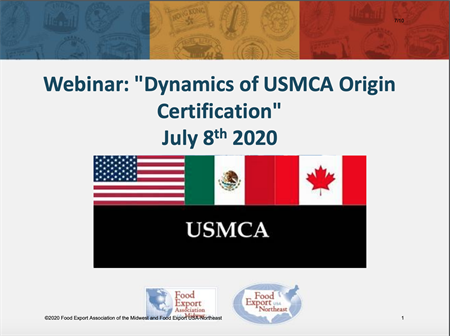Food Export Helpline™ Counselor Dennis Lynch recently hosted a “Dynamics of USMCA Origin Certification” webinar to help U.S. suppliers seeking to understand more about what is required in the new USMCA trade agreement.
The United States-Mexico-Canada Trade Agreement (USMCA) officially entered into force on July 1, 2020 after months of negotiations.
This new trade agreement is a replacement for the North American Free Trade Agreement (NAFTA) which went into force in 1994. The new agreement has numerous updates, many of which reflect the significant changes to online, e-commerce, and other technological advancements that have happened since the early 90’s.
The parts of the agreement that pertain to the agriculture sector have mainly been left alone, with some noted exceptions including more access to the Canadian dairy market
Under NAFTA U.S. suppliers exporting to Mexico or Canada were required to fill out official Certificate of Origin documents. Even before USMCA went into force our Food Export Helpline™ Counselor Dennis Lynch started receiving tons of questions about what Certificate of Origin documents would be required under USMCA.
To help address this question Dennis hosted a recent webinar “Dynamics of USMCA Origin Certification” which you can now view on demand on our website. This webinar goes into detail about the new USMCA agreement and what information U.S. suppliers should include when shipping.

While USMCA does not require an official certificate of origin such as NAFTA CBP 434, there is a minimum set of ‘data elements’ that must be submitted to prove origin. This information helps prove the origin of the goods and shows that they are eligible to receive preferential tariff treatment under USMCA.
We have given a brief overview of the nine data fields that should be included below, but highly recommend you watch the webinar in its entirety to get the full context and better understand what international importers will expect of you.
1. Importer, Exporter, or Producer (indicate which is certifier)
2. Name and Address of Certifier Name and Address of Exporter
3. Name and Address of Producer
4. Named and Address of Importer (if known)
5. Description and HS Code
6. Specific criteria under which the good meets USMCA originating requirements
7. Need to go through the rules of origin steps
8. Date or Blanket period range
9. Authorized signature and date
Your Connection To Growth®
©2024 Food Export Association of the Midwest USA and Food Export USA–Northeast. All Rights Reserved.
Food Export–Midwest and Food Export–Northeast prohibits discrimination in all its programs and activities on the basis of race, color, national origin, religion, sex, gender identity (including gender expression), sexual orientation, disability, age, marital status, familial/parental status, income derived from a public assistance program, political beliefs, reprisal or retaliation for prior civil rights activity. (Not all bases apply to all programs.) Persons with disabilities who require reasonable accommodations or alternative means of communication for program information (e.g., Braille, large print, audiotape, American Sign Language, etc.) should contact us. Additionally, program information may be made available in languages other than English.
To file a program discrimination complaint, complete the USDA Program Discrimination Complaint Form, AD-3027, found online https://www.ascr.usda.gov/filing-program-discrimination-complaint-usda-customer.
Food Export–Midwest and Food Export–Northeast reserve the right to deny services to any firm or individual which, in the sole opinion of Food Export–Midwest and Food Export–Northeast, does not comply with FAS, MAP or Food Export–Midwest and Food Export–Northeast regulations or policies, or otherwise offer the best opportunity to achieve its mission of increasing food and agricultural exports. Submission of any false or misleading information may be grounds for rejection or subsequent revocation of any application or participation. Food Export–Midwest and Food Export–Northeast are equal opportunity employers and providers.
